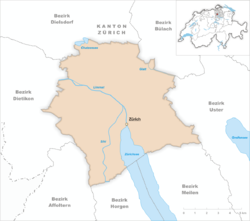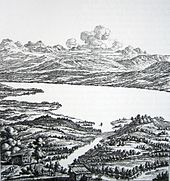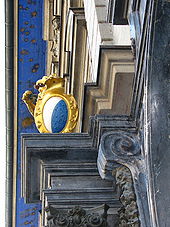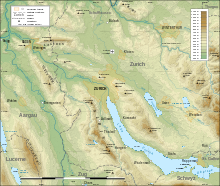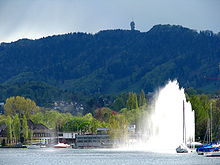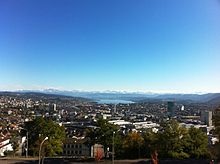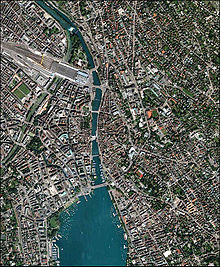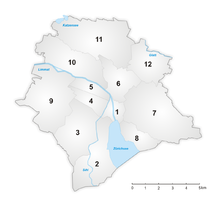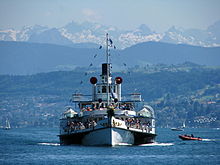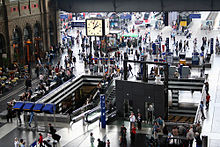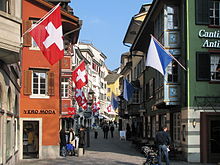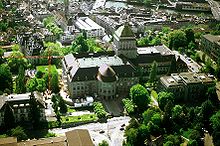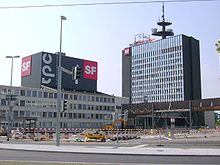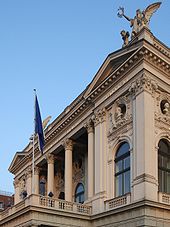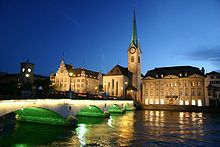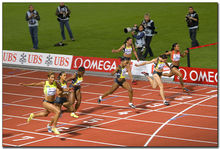- Zurich
-
For other uses, see Zurich (disambiguation).
Zurich Top: Night view of Zurich from Üetliberg, Middle left: National Museum, Middle right: Swiss Federal Institute of Technology, Bottom: View over Zurich and the lake. Country Switzerland 
Canton Zurich District Zurich 47°22′N 8°33′E / 47.367°N 8.55°ECoordinates: 47°22′N 8°33′E / 47.367°N 8.55°E Population 372,047 (Dec 2010)[1] - Density 4,049 /km2 (10,488 /sq mi) Area 87.88 km2 (33.93 sq mi)[2] Elevation 408 m (1,339 ft) - Highest 871 m - Üetliberg - Lowest 392 m - Limmat Postal code 8000–8099 SFOS number 0261 Mayor (list) Corine Mauch (as of 2009) SPS/PSS Twin towns Kunming, San Francisco Website www.stadt-zuerich.ch
SFSO statisticsZurich (German: Zürich, German pronunciation: [ˈtsyːrɪç]; Swiss German: Züri) is the largest city in Switzerland and the capital of the canton of Zurich. It is located in central Switzerland[3] at the northwestern tip of Lake Zurich. While the municipality itself has approximately 380,500 inhabitants, the Zurich metropolitan area is an urbanised area of international importance constituted by a population of nearly 2 million inhabitants.[4] Zurich is a mixed hub for railways, roads, and air traffic. Both Zurich Airport and railway station are the largest and busiest in the country.
Permanently settled for around 7,000 years, the history of Zurich goes back to its founding by the Romans, who, in 15 BC, called it Turicum. During the Middle Ages Zurich gained the independent and privileged status of imperial immediacy and, in 1519, was the place of origin and centre of the Protestant Reformation in German-speaking Switzerland, led by Ulrich Zwingli.[5]
Zurich is a leading global city and among the world's largest financial centres.[6] The city is home to a large number of financial institutions and banking giants. Also, most of the research and development centres are concentrated in Zurich and the low rate of tax attracts overseas companies to set up their headquarters there. According to several surveys from 2006 to 2008, Zurich was named the city with the best quality of life in the world as well as the wealthiest city in Europe.[7][8][9]
An impressive number of museums and art galleries can be found in the city, including the Swiss National Museum and the Kunsthaus.[10] Zurich also hosts one of the most important theatres in the German-speaking world.[11]
Contents
Name
The Swiss standard German pronunciation of the name is [ˈtsyːrɪç] (
 listen). In Zurich German without the final consonant, Züri [ˈtsyɾi], although the adjective remains Zürcher [ˈtsyrxər]. The city is called Zurich [zyʁik] in French, Zurigo [dzuˈriːɡo] in Italian, and Turitg [tuˈritɕ] in Romansh.
listen). In Zurich German without the final consonant, Züri [ˈtsyɾi], although the adjective remains Zürcher [ˈtsyrxər]. The city is called Zurich [zyʁik] in French, Zurigo [dzuˈriːɡo] in Italian, and Turitg [tuˈritɕ] in Romansh.In English, the name is usually written Zurich, without the umlaut. It is pronounced /ˈzjʊərɪk/ (zewr-ik) or /ˈzʊərɪk/ (zoor-ik); more recently sometimes also with /ts/ as in German.[12]
The earliest known form of the city's name is Turicum, attested on a tombstone of the late 2nd century AD in the form STA(tio) TURICEN(sis) ("Turicum tax post"). Neither the name's linguistic origin (most likely Rhaetic or Celtic) nor its meaning can be determined with certainty. A possibility is derivation from *Turīcon, from the Gaulish personal name Tūros.[13] The stress on the long vowel of the Gaulish name, [tuˈriːkon], was lost in German [ˈtsyːʁɪç] but is preserved in Italian Zurigo [dzuˈriːɡo].
A first development towards its later, Germanic form is attested as early as the 6th century with the form Ziurichi. From the 10th century onward, the name has more or less clearly been established as Zürich (Zurih (857), Zurich (924)).[14]
Zurich is sometimes referred to as "Downtown Switzerland" for publicity reasons.[15]
History
Main article: History of ZurichEarly history
Settlements of the Neolithic and Bronze Age were found around Lake Zurich. Traces of pre-Roman Celtic, La Tène settlements were discovered near the Lindenhof hill. In Roman times, Turicum was a tax-collecting point at the border of Gallia Belgica (from AD 90 Germania superior) and Raetia for goods trafficked on the Limmat river. After Emperor Constantine’s reforms in AD 318, the border between Gaul and Italy (two of the four praetorian prefectures of the Roman Empire) was located east of Turicum, crossing the Linth River between Lake Walen and Lake Zurich, where a castle and garrison looked over Turicum’s safety. The earliest written record of the town dates from the 2nd century, with a tombstone referring to it, discovered at the Lindenhof.
In the 5th century, the Germanic Alamanni tribe settled in the Swiss plateau. The Roman castle remained standing until the 7th century. A Carolingian castle, built on the site of the Roman castle by the grandson of Charlemagne, Louis the German, is mentioned in 835 (in castro Turicino iuxta fluvium Lindemaci). Louis also founded the Fraumünster abbey in 853 for his daughter Hildegard. He endowed the Benedictine convent with the lands of Zurich, Uri, and the Albis forest, and granted the convent immunity, placing it under his direct authority. In 1045, King Henry III granted the convent the right to hold markets, collect tolls, and mint coins, and thus effectively made the abbess the ruler of the city.[16]
Zurich became reichsunmittelbar in 1218 with the extinction of the main line of the Zähringer family and attained a status comparable to statehood. During the 1230s, a city wall was built, enclosing 38 hectares, when the earliest stone houses at the Rennweg were built as well. The Carolingian castle was used as a quarry, as it had started to fall into ruin.[17]
Emperor Frederick II promoted the abbess of the Fraumünster to the rank of a duchess in 1234. The abbess nominated the mayor, and she frequently delegated the minting of coins to citizens of the city. The political power of the convent slowly waned in the 14th century, beginning with the establishment of the Zunftordnung (guild laws) in 1336 by Rudolf Brun, who also became the first independent mayor, i.e. not nominated by the abbess.
An important event in the early 14th Century was the completion of the Manesse Codex, a key source of medieval German poetry. The famous illuminated manuscript – described as "the most beautifully illumined German manuscript in centuries;"[18] – was commissioned by the Manesse family of Zurich, copied and illustrated in the city at some time between 1304 and 1340. Producing such a work was a highly expensive prestige project, requiring several years work by highly skilled scribes[19] and miniature painters, and it clearly testifies to the increasing wealth and pride of Zurich citizens in this period.
Old Swiss Confederacy
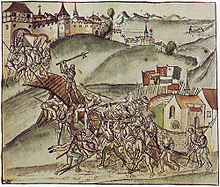 A scene of the Old Zurich War
A scene of the Old Zurich War
On May 1, 1351, the citizens of Zurich had to swear allegiance before representatives of the cantons of Lucerne, Schwyz, Uri and Unterwalden, the other members of the Swiss Confederacy. Thus, Zurich became the fifth member of the Confederacy, which was at that time a loose confederation of de facto independent states. Zurich was the presiding canton of the Diet from 1468 to 1519. This authority was the executive council and lawmaking body of the confederacy, from the Middle Ages until the establishment of the Swiss federal state in 1848. Zurich was temporarily expelled from the confederacy in 1440 due to a war with the other member states over the territory of Toggenburg (the Old Zurich War). Neither side had attained significant victory when peace was agreed upon in 1446, and Zurich was re-admitted to the confederation in 1450.[20]
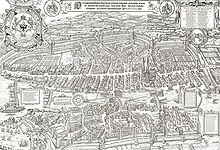 The Murerplan of 1576.
The Murerplan of 1576.
Zwingli started the Swiss Reformation at the time when he was the main preacher in the 1520s, at the Grossmünster. He lived there from 1484 until his death in 1531. The Zurich Bible, based on that of Zwingli, was issued in 1531. The Reformation resulted in major changes in state matters and civil life in Zurich, spreading also to a number of other cantons. Several cantons remained Catholic and became the basis of serious conflicts that eventually led to the outbreak of the Wars of Kappel.
During the 16th and 17th centuries, the Council of Zurich adopted an isolationist attitude, resulting in a second ring of imposing fortifications built in 1624. The Thirty Years' War which raged across Europe motivated the city to build these walls. The fortifications required a lot of resources, which were taken from subject territories without reaching any agreement. The following revolts were crushed brutally. In 1648, Zurich proclaimed itself a republic, shedding its former status of a free imperial city.[21]
The Helvetic Revolution of 1798 saw the fall of the Ancien Régime. Zurich lost control of the land and its economic privileges, and the city and the canton separated their possessions between 1803–1805. In 1839, the city had to yield to the demands of its urban subjects, following the Züriputsch of 6 September. Most of the ramparts built in the 17th century were torn down, without ever having been besieged, to allay rural concerns over the city's hegemony. The Treaty of Zurich between Austria, France, and Sardinia was signed in 1859.[22]
Modern history
Zurich was the Federal capital for 1839–40, and consequently the victory of the Conservative party there in 1839 caused a great stir throughout Switzerland. But when in 1845 the Radicals regained power at Zurich, which was again the Federal capital for 1845–46, Zurich took the lead in opposing the Sonderbund cantons. Following the Sonderbund war and the formation of the Swiss Federal State, Zurich voted in favour of the Federal constitutions of 1848 and of 1874. The enormous immigration from the country districts into the town from the "thirties" onwards created an industrial class which, though "settled" in the town, did not possess the privileges of burghership, and consequently had no share in the municipal government. First of all in 1860 the town schools, hitherto open to "settlers" only on paying high fees, were made accessible to all, next in 1875 ten years' residence ipso facto conferred the right of burghership, while in 1893 the eleven outlying districts were incorporated with the town proper
Extensive developments took place during the 19th century. From 1847, the Spanisch-Brötli-Bahn, the first railway on Swiss territory, connected Zurich with Baden, putting the Zürich Hauptbahnhof at the origin of the Swiss rail network. The present building of the Hauptbahnhof (the main railway station) dates to 1871. Zurich’s Bahnhofstrasse (Station Street) was laid out in 1867, and the Zurich Stock Exchange was founded in 1877. Industrialisation led to migration into the cities and to rapid population growth, particularly in the suburbs of Zurich.
Zurich was accidentally bombed during World War II.
Coat of arms
The blue and white coat of arms of Zurich is attested from 1389, and was derived from banners with blue and white stripes in use since 1315 . The first certain testimony of banners with the same design is from 1434. The coat of arms is flanked by two lions. The red Schwenkel on top of the banner had varying interpretations: For the people of Zurich, it was a mark of honour, granted by Rudolph I. Zurich's neighbours mocked it as a sign of shame, commemorating the loss of the banner at Winterthur in 1292.
Today, the Canton of Zurich uses the same coat of arms as the city.
Government
See also: List of mayors of ZurichThe City Council (Stadtrat) constitutes the executive government of the City of Zurich and operates as a collegiate authority. It is composed of nine councilors, each presiding over a department. The president of the executive department acts as mayor. Current city president is Corine Mauch. Departmental tasks, coordination measures and implementation of laws decreed by the City Parliament are carried by the City Council. The election of the City Council by registered voters is held every four years. The executive body holds its meetings in the City Hall, on the bank of the Limmat. The building was built in 1883 in Renaissance style.
On the other hand, the City Parliament (Gemeinderat) holds the legislative power. It is made up of 125 members, with elections also held every four years. The City Parliament decrees regulations and by-laws that are executed by the City Council and the administration. The sessions of the City Parliament are public. Unlike the member of the City Council, the members of the City Parliament are not politicians by profession, but they are paid a fee based on their attendance. Any resident of Zurich allowed to vote can be elected as a member of the City Parliament. The legislative body holds its meetings in the Town Hall, opposite to the City Hall.[23]
As of 2010, the Zurich City Council is made up of four representatives of the SDP (Social Democratic Party, one of whom is the mayor), two members of the FDP (Free Democratic Party), two members of the Green Party and one member of the CVP (Christian Democratic Party).[24]
Geography
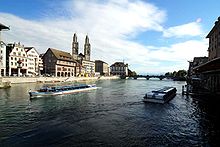 The Limmat river in Zurich
The Limmat river in Zurich
Zurich is situated at 408 meters (1,339 ft) above sea level on the lower (northern) end of Lake Zurich (Zürichsee) about 30 kilometers (19 mi) north of the Alps, nestling between the wooded hills on the west and east side. The Old Town stretches on both sides of the Limmat river, which flows from the lake, running northwards at first and then gradually turning into a curve to the west. The geographic (and historic) centre of the city is the Lindenhof, a small natural hill on the west bank of the Limmat, about 700 metres (2,300 ft) north of where the river issues from Lake Zurich. Today the incorporated city stretches somewhat beyond the natural hydrographic confines of the hills and includes some neighbourhoods to the northeast in the Glatt Valley (German: Glattal) and to the north in the Limmat Valley (German: Limmattal). The boundaries of the older city are easy to recognize by the Schanzengraben canal. This artificial watercourses has been used for the construction of the third fortress in the 17th and 18th centuries.
Topography
The municipality of Zurich has an area of 91.88 square kilometres (35.48 sq mi), of which 4.1 km2 (1.6 sq mi) is made up of Lake Zurich. The area includes a section of the northern Swiss Plateau. The banks of the Limmat constitute the densest part of the city. The river is oriented in the southeast-northwest direction, with the flat valley floor having a width of two to three kilometres. The partially channelled and straightened Limmat does not flow in the central part of the valley, but always along its right (northeastern) side. The river Sihl meets with the Limmat at the end of Platzspitz, which borders the Swiss National Museum. The Limmat reaches the lowest point of the municipality in Oberengstringen at 392 m (1,286 ft) above sea level.
On its west side the Limmat valley is flanked by the wooded heights of the Albis chain, which runs along the western border. The Üetliberg is, with 869 m (2,851 ft) above sea level, the highest elevation of the surrounding area. Its summit can be reached easily by the Uetlibergbahn. From the platform of the observation tower on the summit, an impressive panorama of the city, the lake and the Alps can be seen.
The northeast side of the Limmat valley includes a range of hills, which marks the watershed between the Limmat and the Glatt. From the northwest to the southeast, the height of the mostly wooded knolls increases: the Gubrist (615 m/2,018 ft), the Hönggerberg (541 m/1,775 ft), the Käferberg (571 m/1,873 ft), the Zürichberg (676 m/2,218 ft) and the Adlisberg (701 m/2,300 ft). Between the Käferberg and the Zürichberg is located the saddle of the Milchbuck (about 470 m/1,540 ft), an important passage from the Limmat valley to the Glatt valley.
The northernmost part of the municipality extends to the plain of the Glatt valley and to the saddle which makes the connection between the Glattal and Furttal. Also a part of the Katzensee (nature reserve) and the Büsisee, both of which are drained by the Katzenbach to Glatt, belong to the city.
Climate
Zurich has, depending on the definition used, an oceanic or humid continental climate (Köppen Cfb/Dfb), with four distinct seasons. Decisive for the climate of Zurich are both the winds from westerly directions, which often result in precipitation and, on the other hand, the Bise (east or north-east wind), which is usually associated with high-pressure situations, but cooler weather phases with temperatures lower than the average. The Foehn wind, which plays an important role in the northern alpine valleys, has a limited impact on Zurich.
The annual mean temperature at the measuring station of the Federal Office of Meteorology and Climatology in Zurich (556 m [1,824 ft] above sea level on the slope of the Zürichberg, 150 m [490 ft] above the level of the city centre) is 8.5 °C (47.3 °F). The coldest month mean temperatures are measured in January with −0.5 °C (31.1 °F) and the warmest are measured in July with 17.6 °C (63.7 °F). On average there are 88 days in which the minimum temperature is below 0 °C (32 °F), and 26 days in which the maximum temperature is below 0 °C (32 °F). There are on average 30 summer days (above 25 °C [77 °F]) throughout the year, while hot days (with a temperature reaching 30 °C [86 °F]) are only three. The average high temperature in July are 23.6 °C (74.5 °F) and low temperature are 11.6 °C (52.9 °F). Spring and autumn are generally cool to mild. These values are relatively low compared to other stations on the plateau but they can be explained by the altitude of the station. In the Limmat valley more summer days and hot days can be expected. Zurich has an average of 1,482 hours of sunshine per year. The 1,136 millimetres (44.7 in) rainfall spread throughout the year. During the warmer half of the year and especially the three summer months, levels of rainfall are higher than those measured in winter. The meteorological station at Kloten gives an average precipitation of 1,031 millimetres (40.6 in).
Climate data for Zurich (Kloten, 1961–1990) Month Jan Feb Mar Apr May Jun Jul Aug Sep Oct Nov Dec Year Average high °C (°F) 2.0
(35.6)4.5
(40.1)8.8
(47.8)13.2
(55.8)17.9
(64.2)21.2
(70.2)23.6
(74.5)22.7
(72.9)19.5
(67.1)13.7
(56.7)7.0
(44.6)3.1
(37.6)13.1 Average low °C (°F) −4.1
(24.6)−3.2
(26.2)−0.7
(30.7)2.5
(36.5)6.4
(43.5)9.7
(49.5)11.6
(52.9)11.2
(52.2)8.5
(47.3)4.9
(40.8)0.2
(32.4)−2.8
(27.0)3.7 Precipitation mm (inches) 67
(2.64)68
(2.68)68
(2.68)78
(3.07)96
(3.78)115
(4.53)106
(4.17)121
(4.76)83
(3.27)70
(2.76)84
(3.31)74
(2.91)1,031
(40.59)% humidity 86.0 81.5 75.5 72.8 72.4 72.9 72.2 75.2 78.9 84.9 85.4 86.1 78.7 Avg. precipitation days 10.9 9.5 10.9 11.6 12.4 12.2 11.2 11.5 8.4 8.0 10.1 10.4 127.1 Sunshine hours 35 69 115 144 176 191 223 195 155 92 49 31 1,475 Source: MeteoSchweiz [25] Climate protection
The city of Zurich is among the world-leaders in protecting the climate by following a manifold approach. In November 2008[26] the people of Zurich voted in a public referendum to write into law the quantifiable and fixed deadline of one tonne of CO2 per person per annum by 2050. This forces any decision of the executive to support this goal, even if the costs are higher in all dimensions. Some examples are the new disinfection section of the public city hospital in Triemli (Minergie-P quality – passive house)[clarification needed], the continued optimisation and creation of public transportation, enlargement of the bicycle-only network, research and projects for renewable energy and enclosure of speed-ways[clarification needed].
Urban area
The areas surrounding the Limmat are almost completely built over (residential, industrial areas, commercial zones). Also densely built, the sun-exposed and preferred residential locations on the hills overlooking Zurich, Waidberg and Zürichberg and the bottom section of the slope on the western side of the valley on the Üetliberg.
The green lungs of the city include the vast forest areas of Adlisberg, Zürichberg, Käferberg, Hönggerberg and Üetliberg. Major parks are also located along the lakeshore (Zurichhorn and Enge). Furthermore, the cultivated area through parks and gardens is loosened. Larger contiguous agricultural lands are located near Affoltern and Seebach. Of the total area of the municipality of Zurich (in 1996, without the lake), 45.4% are settlements, industry and commerce, 15.5% are transports, 26.5% are forests, 11%: is agriculture and 1.2% is water.
View over Zurich and Lake Zurich from the Üetliberg
City districts
Main article: Subdivisions of ZurichThe previous boundaries of the city of Zurich (before 1893) were more or less synonymous with the location of the old town. Two large expansions of the city limits occurred in 1893 and in 1934 when the city of Zurich merged with many surrounding municipalities, that had been growing increasingly together since the 19th century. Today, the city is divided into twelve districts (known as Kreis in German), numbered 1 to 12, each one of which may contain anywhere between 1 and 4 neighborhoods:
- District 1, known as Altstadt, contains the old town, both to the east and west of the start of the Limmat river.
- District 2 lies along the west side of Lake Zurich, and contains the neighbourhoods of Enge, Wollishofen and Leimbach.
- District 3, known as Wiedikon is between the Sihl river and the Üetliberg, and contains the neighbourhoods of Alt-Wiedikon, Sihlfeld and Friesenberg.
- District 4, known as Aussersihl lies between the Sihl and the train tracks leaving Zürich Hauptbahnhof.
- District 5, known as Industriequartier, is between the Limmat and the train tracks leaving Zürich Hauptbahnhof, it contains the former industrial area of Zurich which has gone under a large-scale rezoning to create upscale modern housing, retail and commercial real estate.
- District 6 is on the edge of the Zürichberg, a hill overlooking the eastern part of the city. District 6 contains the neighbourhoods of Oberstrass and Unterstrass. There neighbourhoods are home to Zurich's wealthiest and more prominent residents.
- District 7 is on the edge of the Adlisberg hill as well as the Zürichberg, on the eastern side of the city. District 7 contains the neighbourhoods of Hottingen and Hirslanden.
- District 8, known as Riesbach, lies on the eastern side of Lake Zurich.
- District 9 is between the Limmat to the north and the Üetliberg to the south. It contains the neighbourhoods Altstetten and Albisrieden.
- District 10 is to the east of the Limmat and to the south of the Hönggerberg and Käferberg hills. District 10 contains the neighbourhoods of Höngg and Wipkingen.
- District 11 is in the area north of the Hönggerberg and Käferberg and between the Glatt valley and the Katzensee (Cats Lake). It contains the neighbourhoods of Affoltern, Oerlikon and Seebach.
- District 12, known as Schwamendingen, is located in the Glattal (Glatt valley) on the northern side of the Zürichberg.
Most of the district boundaries are fairly similar to the original boundaries of the previously existing municipalities before they were incorporated into the city of Zurich.
Transport
See also: Zurich modelPublic transport is extremely popular in Zurich, and its inhabitants use public transport in large numbers. About 70% of the visitors to the city use the tram or bus, and about half of the journeys within the municipality take place on public transport.[27] Within Zurich and throughout the canton of Zurich, the ZVV network of public transport has traffic density ratings among the highest worldwide. When adding frequency, which in Zurich can be as often as seven minutes, it does become the densest across all dimensions. Three means of mass-transit exist: the S-Bahn (local trains), trams, and buses (both diesel and electric, also called trolley buses). In addition, the public transport network includes boats on the lake and river, funicular railways and even the Luftseilbahn Adliswil-Felsenegg (LAF), a cable car between Adliswil and Felsenegg. Tickets purchased for a trip are valid on all means of public transportation (train, tram, bus, boat). The Zürichsee-Schifffahrtsgesellschaft (commonly abbreviated to ZSG) operates passenger vessels on the Limmat river and the Lake Zurich, connecting surrounding towns between Zurich and Rapperswil.
Zurich is a mixed hub for railways, roads, and air traffic. Zürich Hauptbahnhof is the largest and busiest station in Switzerland and is an important railway hub in Europe. It has several other railway stations, including Oerlikon, Stadelhofen, Hardbrücke, Tiefenbrunnen, Enge, Selnau, Wiedikon and Altstetten. The railway network is mainly operated by the Federal Railways but Zurich is also served by the major InterCity trains from the neighbouring countries.
Zurich Airport is located less than 10 kilometers (6.2 mi) northeast of the city in Kloten. Zurich Airport has its own railway station, which is located underground. It is directly connected to Zurich and most of the major Swiss cities. There is also an airfield in Dübendorf.
The A1, A3 and A4 motorways pass close to Zurich. The A1 heads west towards Bern and Geneva and eastwards towards St. Gallen; the A4 leads northwards to Schaffhausen; and the A3 heads northwest towards Basel and southeast along Lake Zurich and Lake Walen towards Sargans.
Demographics
There are about 380,000 people living in Zurich (as of 2010[update]),[28] making it Switzerland's largest city. Of registered inhabitants, 30.6% (115,379 people) do not hold Swiss citizenship.[29] Of these, German citizens make up the largest group with 22.0%, followed by Italians. The population of the city proper including suburbs totals 1.08 million people.[30] The entire metropolitan area (including the cities of Winterthur, Baden, Brugg, Schaffhausen, Frauenfeld, Uster/Wetzikon, Rapperswil-Jona and Zug) has a population of around 1.68 million people.[31]
Languages
The official language used by the government and in most publications is German, while the main language is Zurich German (Züritüütsch), which is a dialect of Alemannic. As of 2000, speakers with Alemannic or German as their mother-tongue make up 77.7% of the population. Italian follows behind at 4.7% of the population. Other native languages spoken by more than 1% of the population include South Slavic languages (2.2%)—this includes Serbian, Bosnian, Croatian, Macedonian, and Slovenian, Spanish (2.2%), French (2.1%), English (1.8%), Portuguese (1.6%), Albanian (1.5%).[32]
Religion
After the Reformation led by Huldrych Zwingli, Zurich was a centre and stronghold of Protestantism in Switzerland. Over the course of the 20th century, a significant number of Catholics settled in the city, and Catholics instead of Protestants became the largest denomination - although not representing a majority of the total population; in 2000, Catholics were the largest single denomination at 33.3% of the population.[33] At the end of 2009, a plurality of the population of the canton did not declare a religion, claimed no faith, or identified with a non-Christian religion.[34] In the city of Zurich, at the end of 2010, 165,686 (or 45%) had no faith, did not respond, or identified with another confession, Catholics numbered 111,946 (30%), and members of the Swiss Reformed Church numbered 94,419 (or 25%) [35]
Social
The level of unemployment in Zurich was 2.6%[36] in August 2007. About 4% of the city population, 15,500, live either directly or indirectly on welfare payment from the state (April 2005).[37]
Main sights
Further information: Zurich old town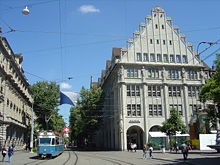 The Bahnhofstrasse seen from Paradeplatz
The Bahnhofstrasse seen from Paradeplatz
Most of Zurich's sights are located within the area on either side of the Limmat river, between the Main railway station and Lake Zurich. The churches and houses of the old town are clustered here, as are the most expensive shops along the famous Bahnhofstrasse. The Lindenhof in the old town is the historical site of the Roman castle, and the later Carolingian Imperial Palace.
Churches
- Grossmünster (great minster) (near Lake Zurich, on the Eastern side of the Limmat River in the old city), where Zwingli was pastor; first built around 820; declared by Charlemagne imperial church
- Fraumünster (our lady's minster) first church built before 874; the Romanesque choir dates from 1250–70; Marc Chagall stained glass choir windows; (on the opposite side of the Limmat). During 2004 the Fraumünster was fully renovated. During this period the installed scaffolding went above the tip of the tower allowing a unique and exceptional 360° panoramic view of Zurich.
- St. Peter (downstream from the Fraumünster, in the old city); with the largest church clock face in the world.[citation needed]
Museums
- Zurich Museum of Art – The Museum of Art, also known as Kunsthaus Zürich, is one of the significant art museums of Europe. It holds one of the largest collections in Classic Modern Art in the world (Munch, Picasso, Braque, Giacometti, etc.). The museum also features a large library collection of photographs.[38]
- Swiss National Museum – The National Museum (German: Landesmuseum) displays many objects that illustrate the cultural and historical background of Switzerland. It also contains many ancient artifacts, including stained glass, costumes, painted furniture and weapons. The museum is located in the Platzspitz park opposite to the Hauptbahnhof.[39]
- Centre Le Corbusier – Located on the shore of the Lake Zurich nearby Zürichhorn, the Centre Le Corbusier (also named: Heidi Weber Museum), is an art museum dedicated to the work of the Swiss architect Le Corbusier, inside the last house he designed.
- Rietberg Museum – The Rietberg Museum, situated in Gablerstrasse, is one of the great repositories of art and culture in Zurich. The museum also displays exhibits gathered from various corners of the world: bronze artifacts from Tibet, ceramics and jade, Indian sculpture, Chinese grave decorations, masks by African tribes etc.
- Museum of Design – The Museum of Design is a museum for industrial design, visual communication, architecture and craft. It is part of the Department of Cultural Analysis of the Zurich University of the Arts.[40]
- Haus Konstruktiv – The Haus Konstruktiv is a museum with Swiss-wide and international recognition. The museum is about constructive, concrete and conceptual art and design. It testimonies to Zurich’s industrial architecture in the immediate vicinity of the Main Station.[41]
- Uhrenmuseum Beyer – The Uhrenmuseum is located in the heart of the city. Documenting the history of timekeeping and timekeepers, the museum is home to a large collection of mechanical timepieces as well as a collection of primitive time keeping devices such as water clocks, sundials and hourglasses
- Guild houses – The Guild houses (German: Zunfthaus) are located along the Limmat river (downstream from the Grossmünster): Meisen (also a porcellan and fayence museum), Rüden, Haue, Saffran, Schneidern, Schmiden, Zimmerleuten, and some more.
- Tram Museum - The Tram Museum is located at Burgwies in Zurich's eastern suburbs, and chronicles the history of Zurich's iconic tram system with exhibits varying in date from 1897 to the present day.
Parks and nature
- Zoological Garden – The zoological garden holds about 260 species of animals and houses about 2200 animals. One can come across separate enclosures of snow leopards, India lions, clouded leopards, Amur leopards, otters and pandas in the zoo.[42]
- Botanical Garden – The Botanical Garden houses about 15,000 species of plants and trees and contains as many as three million plants. In the garden, many rare plant species from south western part of Africa, as well as from New Caledonia can be found. The University of Zurich holds the ownership of the Botanical Garden.
- Chinese Garden – The Chinese Garden is a gift by Zurich's Chinese partner town Kunming, as remiscence for Zurich's technical and scientific assistance in the development of the Kunming city drinking water supply and drainage. The garden is an expression of one of the main themes of Chinese culture, the «Three Friends of Winter» – three plants that together brave the cold season – pine, bamboo, and plum.
- Üetliberg – Located to the west of the city at an altitude of 813 metres (2,667 ft) above sea level, the Üetliberg is the highest hill and offers views over the city. The summit is easily accessible by train from Zurich main station.[43]
Architecture
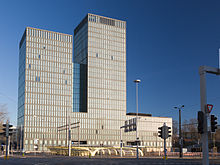 The 88 metre[44] Sunrise Tower (2005) was the first approved high-rise building in twenty years
The 88 metre[44] Sunrise Tower (2005) was the first approved high-rise building in twenty years
Compared to other cities, there are few tall buildings in Zurich. The municipal building regulations (Article 9)[45] limit the construction of high-rise buildings to areas in the west and north of the city. In the industrial district, in Altstetten and Oerlikon, buildings up to 80 metres (260 ft) in height are allowed (high-rise area I). In the adjacent high-rise areas II and III the height is limited to 40 metres (130 ft). Around the year 2000, regulations became more flexible and high-rise buildings were again planned and built. The people's initiative "40 meters is enough," which would have reduced both the maximum height and the high-rise buildings area, was clearly rejected on 29 November 2009.[46] At this time in Zurich about a dozen high-rises buildings were under construction or in planning, including the Prime Tower as the tallest skyscraper in Switzerland.
World heritage sites
The prehistoric settlements at Enge Alpenquai and Grosse Stadt Kleiner Hafner are part of the Prehistoric Pile dwellings around the Alps a UNESCO World Heritage Site.[47]
Economy
Zurich is a leading financial center and global city.[6] The Greater Zurich Area is Switzerland's economic centre and home to a vast number of international companies. By far the most important sector in the economy of Zurich is the service industry, which employs nearly four fifths of workers. Other important industries include light industry, machine and textile industries and tourism. Most Swiss banks have their headquarters in Zurich and there are numerous foreign banks in the Greater Zurich Area. Located in Zurich, the Swiss Stock Exchange was established in 1877 and is nowadays the fourth most prominent stock exchange in the world. In addition Zurich is the world's largest gold trading centre. Ten of the country's 50 largest companies have their head offices in Zurich, among them UBS,[48] Credit Suisse, Swiss Re and Zurich Financial Services.[49]
Contributory factors to economic strength
The high quality of life has been cited as a reason for economic growth in Zurich. The consulting firm Mercer has for many years ranked Zurich as a city with the highest quality of life in the world.[7][8] In particular, Zurich received high scores for work, housing, leisure, education and safety. Local planning authorities ensure clear separation between urban and recreational areas and there are many protected nature reserves.[50] Other cities in the country, Bern and Geneva, were also listed among the top ten. Zurich is also ranked the sixth most expensive city in the world. In 2008, Zurich was ranked ninth. The city ranked behind Hong Kong and ahead of Copenhagen. It is the third most expensive city in Europe and second most expensive city in Switzerland after Geneva.[51]
Zurich benefits from the high level of investment in education that is typical of Switzerland in general and provides skilled labour at all levels. The city is home to two major universities, thus enabling access to graduates and high technology research. Professional training incorporates a mix of practical work experience and academic study while, in general, emphasis is placed on obtaining a good level of general education and language ability. As a result the city is home to many multilingual people and employees generally demonstrate a high degree of motivation and a low level of absenteeism. Such characteristics are reflected in the high level of productivity the region enjoys and account for the opening of offices and research centres in the city by large corporations.[50]
The Swiss stock exchange
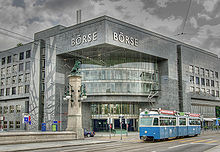 The Swiss stock Exchange on Selnaustrasse.
The Swiss stock Exchange on Selnaustrasse.
The Swiss stock exchange is called SIX Swiss Exchange, formerly known as SWX. The SIX Swiss Exchange is the head group of several different worldwide operative financial systems: virt-x, Eurex, Eurex US, EXFEED and STOXX. The exchange turnover generated at the SWX was in 2007 of 1,780,499.5 million CHF; the number of transactions arrived in the same period at 35,339,296 and the Swiss Performance Index (SPI) arrived at a total market capitalization of 1,359,976.2 million CHF.[52][53]
The SIX Swiss Exchange goes back more than 150 years. In 1996, fully electronic trading replaced the traditional floor trading system at the stock exchanges of Geneva (founded in 1850), Zurich (1873) and Basel (1876).
Since 2008, the SIX Swiss Exchange has been part of the SIX Group, as SWX Group, SIS Group and Telekurs Group merged.
Education and research
About 60,000 people study at the 20 universities, colleges and institutions of higher education in Zurich. Two of Switzerland's most distinguished universities are located in the city. The Swiss Federal Institute of Technology (ETH Zurich) which is controlled by the (federal) state and the University of Zurich that is under direction of the canton of Zurich. Both universities were listed in the top 50 world universities rated in 2007.[54]
ETH was founded in 1854 by the Swiss Confederation and opened its doors in 1855 as a polytechnic institute. ETH achieved its reputation particularly in the fields of chemistry, mathematics and physics and there are 21 Nobel Laureates who are associated with the institution. ETH is usually ranked the top university in continental Europe.[55] The institution consists of two campuses, the main building in the heart of the city and the new campus on the outskirts of the city.
The University of Zurich was founded in 1833, although its beginnings date back to 1525 when the Swiss reformer Ulrich Zwingli founded a college of theology. Nowadays with its 24,000 students and 1,900 graduations each year, the University of Zurich is the largest in Switzerland and offers the widest range of subjects and courses at any Swiss higher education institution.
The Pedagogical College, the Zurich University of Applied Sciences (ZHAW) and the Zurich University of the Arts (ZHdK) are another three top-class technical colleges which contribute to Zurich's reputation as a knowledge and research pole by providing applied research and development. Zurich is also one of the co-location centres of the Knowledge and Innovation Community (Climate Change Mitigation and Adaptation) of the European Institute of Innovation and Technology.[56]
State universities by size in Canton Zurich
Only (federal) state Universities and higher education institutions,
Rank Institution Total students 1 University of Zurich - UZH 25,618 2 Zurich University of Applied Sciences - ZFH 15,334 3 Swiss Federal Institute of Technology Zurich - ETH 15,093 List of largest universities by enrollment in Switzerland
Media
Many large Swiss media conglomerates are headquartered in Zurich, such as tamedia, Ringier and the NZZ-Verlag. Zurich is one of the most important media locations in the German speaking part of the country. This status has been recently reinforced by the increase in availability of online publications published in Zurich.[citation needed]
Television and radio
The headquarters of Switzerland's national licence fee funded German language television network ("SF") are located in the Leutschenbach neighborhood, to the north of the Oerlikon train station. Regional commercial television station "TeleZüri" (Zurich Television) has its headquarters near Escher-Wyss Platz. The production facilities for other commercial stations "Star TV", "u1" TV and "3+" are located in Schlieren.
One section of the Swiss German language licence fee funded public radio station "Schweizer Radio DRS" is located in Zurich. There are commercial local radio stations broadcasting from Zurich, such as "Radio 24" on the Limmatstrasse, "Energy Zürich" in Seefeld on the Kreuzstrasse, Radio "LoRa" and "Radio 1". There are other radio stations that operate only during certain parts of the year, such as "CSD Radio" (May/June), "Radio Streetparade" (July/August) and "rundfunk.fm" (August/September).
Print media
There are three large daily newspapers published in Zurich that are known across Switzerland. The Neue Zürcher Zeitung (NZZ), the Tages-Anzeiger and the Blick, the largest Swiss tabloid. All three of those newspapers publish Sunday editions. These are the "NZZ am Sonntag", "SonntagsZeitung" and "SonntagsBlick". Besides the three main daily newspapers, there are free daily commuter newspapers which are widely distributed: 20 Minuten (20 minutes), published weekdays in the mornings and Blick am Abend,[57] weekdays but in the late afternoon.
There are a number of magazines from major publishers that are based in Zurich. Some examples are: Bilanz, Die Weltwoche, and Annabelle.
Culture
See also: List of annual events in Zurich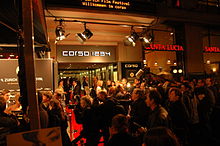 Opening of the Zurich Film Festival (2008)
Opening of the Zurich Film Festival (2008)
Zurich has a rich cultural tradition. In addition to high-quality museums and galleries, Zurich has high-calibre chamber and symphony orchestras and several important theatres.[58]
The Zurich Film Festival is one of the most important upcoming international film festivals. In just a few years, the Festival became firmly established upon the national and international festival landscape. Over the course of 11 days, it attracts both stars and new talents and celebrates popular international productions.[59]
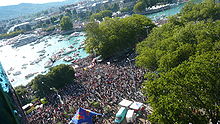 Zurich during the Street Parade (2008)
Zurich during the Street Parade (2008)
One of the largest and most popular annual events in Zurich is the Street Parade, which is also one of the largest techno and dance music festivals in the world. Proceeding along the side of Lake Zurich, it normally occurs on the second Saturday in August. The first edition was held In 1992 with about 1,000 participants. By 2001 the event had reached the size of 1 million participants.[60][61] The Zürifäscht, on the other hand, is a triennial public festival. It features music, fireworks set to music,[61] and other attractions throughout the old town. It is the largest public festival in Switzerland and is attended by up to 2 million visitors.[62]
The Kunst Zürich is an international contemporary art fair with an annual guest city; it combines most recent and youngest art with the works of well-established artists.[63] Another annual public art exhibit is the city campaign, sponsored by the City Vereinigung (the local equivalent of a chamber of commerce) with the cooperation of the city government. It consists of decorated sculptures distributed over the city centre, in public places. Past themes have included lions (1986), cows (1998), benches (2003), teddy bears (2005), and huge flower pots (2009). From this originated the concept of the CowParade that has been featured in other major world cities.
Zurich is also the home to several art movements. The Cabaret Voltaire where the Dada movement was founded in 1916. Constructive Art Movement took also one of the first steps in Zurich. Artists like Max Bill, Marcel Breuer, Camille Graeser or Richard Paul Lohse had their ateliers in Zurich, which became even more important after the takeover of power by the Nazi-Regime in Germany and World War II.
The best known traditional holiday in Zürich is the Sechseläuten (Sächsilüüte), including a parade of the guilds and the burning of "winter" in effigy. Another is the Knabenschiessen target shooting competition for teenagers (originally boys, open to female participants since 1991).
Opera, ballet and theaters
The Zurich Opera House (German: Zürcher Opernhaus) is one of the principal opera houses in Europe. Built in 1834, it was the first permanent theatre in the heart of Zurich and was at the time, the seat of Richard Wagner's activities. Later in 1890, the theatre was re-built as an ornate building with a neo-classical architecture. The portico is made of white and grey stone ornamented with the busts of Wagner, Weber and Mozart. Later, busts of Schiller, Shakespeare and Goethe were also added. The auditorium is designed in the rococo style. Once a year, it hosts the Zürcher Opernball with the President of the Swiss Confederation and the economic and cultural élite of Switzerland.[64]
The Schauspielhaus Zürich is the main theatre complex of the City. It has two dépendances: Pfauen in the Central City District and Schiffbauhalle, an old industrial hall, in Zurich West. The Schauspielhaus was home to emigrants such as Bertolt Brecht or Thomas Mann, and saw premieres of works of Max Frisch, Friedrich Dürrenmatt, Botho Strauss or Elfriede Jelinek. The Schauspielhaus is one of the most prominent and important theatres in the German-speaking world.[65]
The Theater am Neumarkt is one of the oldest theatres of the city. Established by the old guilds in the Old City District, it is located in a baroque palace near Niederdorf Street. It has two stages staging mostly avantgarde works by European directors.
The Zürcher Theater Spektakel is an international theatre festival, ranking among the most important European festivals for contemporary performing arts.[66]
Food
The traditional cuisine of Zurich consists of traditional fare, reflecting the centuries of rule by patrician burghers as well as the lasting imprint of Huldrych Zwingli's puritanism. Traditional dishes include Zürcher Geschnetzeltes and Tirggel.
Nightlife and clubbing
Zurich offers a great deal of variety when it comes to night-time leisure. It is the host city of the world-famous Street Parade, which takes place in August every year.
The most famous districts for Nightlife are the Niederdorf in the old town with bars, restaurants, lounges, hotels, clubs, etc. and a lot of fashion shops for a young and stylish public and the Langstrasse in the districts 4 and 5 of the city. There are authentic amusements: Brazilian bars, punk clubs, HipHop stages, Caribic restaurants, arthouse-cinemas, Turkish kebabs and Italian espresso-bars, but also sex shops or the famous red light district of Zurich.
In the past ten years new parts of the city have risen into the spotlight. Notably, the area known as Zurich West in district 5, near the Escher-Wyss square and the S-Bahn Station of Zurich Hardbrücke.
Sports
The people of Zurich enjoy an active lifestyle and sport is an integral part of Swiss culture and society. The abundance of international sporting facilities make Zurich an attractive place for sport lovers and several international sport federations are located in the city.
Association football is an essential aspect of sports in Zurich. The city is home to two major Swiss football teams listed in Switzerland's highest league; Grasshopper-Club Zürich founded in 1886 and FC Zürich which has existed since 1896. The Fédération Internationale de Football Association (FIFA) is headquartered in the city. In 2007 were inaugurated the new FIFA headquarters building, designed by architect Tilla Theus
Among the most popular sports in Switzerland is ice hockey. In Zurich it is represented by the ZSC Lions. The International Ice Hockey Federation (IIHF) officiating as head organisation for ice hockey leagues worldwide is based in Zurich as well.
Biking is a popular sport as well as a mean of transport in Zurich. Biking routes are generally marked with red and white signs and the yellow lanes are exclusively meant for the bikers. Also hiking trails are well marked with yellow signs, which give the hiker the probable time it will take him to reach his destination. There are specific maps available for hiking and walking trails throughout Switzerland. Some of the most accessible walks in the Zurich area are the Üetliberg and the Zürichberg.
As many as 30 clubs and 7 indoor Curling facilities can be found in the greater Zurich area. The Curling season starts in early September and continues until the end of April.[67]
Events
Weltklasse Zürich, sometimes referred to as the one day Olympics, is one of prestigious one day athletics meet held annually at the Letzigrund Stadium. The Weltklasse is reputed as one of the best and most classy athlete meet in the world after the Olympics. Since it started on August 12, 1928, the sporting event has witnessed new world records and national records. Till date as many as 24 world records were set in Weltklasse.[68][69][70]
Zurich Marathon is a popular sport event, inviting numerous athletes from every corner of the globe. Zurich Marathon is a long distance running event, covering approximately 43 kilometres (27 mi) at one stretch. The running course starts from Zurich and passes through Bahnhofstrasse, Bellevue, Mythenquai, Quaibrücke, Talstrasse and Utoquai, and along Lake Zurich to several other places. New Year's Eve run is another important running event. The race is held on January 1 each year and the start takes place at midnight exactly.
Zurich was one of six venues of the 1954 FIFA World Cup and one of eight venues of the UEFA Euro 2008. The Euro 2008 games were held in the Letzigrund Stadium. Work on the new Letzigrund was completed in exceptionally quick time and the stadium opened in August 2007 just one year after the demolition of the old arena.
Zurich also hosted the 1998 World Ice Hockey Championships. The city previously co-hosted the 1953 and 1939 editions.
Notable people
People who were born or died in Zurich:
- Grand Duchess Marie Alexandrovna of Russia (1853–1920), Duchess of Edinburgh, died in Zurich
- Richard Avenarius (1843–1896), Philosopher, died in Zurich
- Diego Benaglio (born 1983), footballer, born in Zurich
- Severin Blindenbacher (born 1983), ice hockey player, born in Zurich
- Felix Bloch (1905–1983), physicist, born in Zurich
- Heinrich Bullinger (1504–1575), reformer and theologian, died in Zurich
- Elias Canetti (1905–1994), novelist, died in Zurich
- Wilhelm Filchner (1877–1957), explorer, died in Zurich
- Max Frisch (1911–1991), novelist, born and died in Zurich
- Christoph Froschauer (ca. 1490/1–1564), Printer of the Froschauer Bible, died in Zurich
- Patrick Geering (born 1990), ice hockey player, born in Zurich
- Conrad Gessner (1516–1565), naturalist, born and died in Zurich
- Marcel Grossmann (1878–1936), mathematician, died in Zurich
- Otto Hunziker (1873–1959), pioneer in the international dairy industry, born in Zurich
- James Joyce (1882–1941), Irish novelist, died in Zurich (buried at Fluntern cemetery in Zurich)
- Carl Jung (1875–1961), psychiatrist, lived and died in Zurich
- Gottfried Keller (1819–1890), poet, born and died in Zurich
- Amanullah Khan (1929–1960), deposed Afghan reformist King, died in Zurich
- Otto Klemperer (1885–1973), German conductor, died in Zurich (buried at Israelitischer Friedhof Oberer Friesenberg)
- Hugo Koblet (1925–1964), cycling champion, born in Zurich
- Johann Kaspar Lavater (1741–1801), poet and physiognomist, born in Zurich
- Antonio Ligabue (1899–1965), Italian painter, born in Zurich
- Hugo Loetscher (1929–2009), writer, born and died in Zurich
- Dieter Meier (born 1945), conceptual artist and musician with electronica group Yello, born in Zurich
- Conrad Ferdinand Meyer (1825–1898), poet, born in Zurich
- Wolfgang Pauli (1900–1958), physicist, died in Zurich
- Johann Heinrich Pestalozzi (1746–1827), educational reformer, born in Zurich
- James Sadleir (c. 1815–1881), fugitive swindler, murdered in Zurich
- Johann Jakob Scheuchzer (1672–1733), scholar, born in Zurich
- Roland Scholl (1865–1945), chemist, born in Zurich
- Johanna Spyri (1827–1901), author of Heidi, died in Zurich
- Tobias Stephan (born 1984), ice hockey player, born in Zurich
- Stefi Talman (born 1958), Swiss shoe designer, born in Zurich
- Pancho Vladigerov (1899–1978), Bulgarian composer, born in Zurich
- Ueli Gegenschatz (1971–2009), Swiss BASE jumper, died in Zurich after a failed jump from the Sunrise Tower
Famous residents:
- Gustav Bertha (2000–2009)
- Boris Blank, musician with Yello
- Mileva Maric, Serbian mathematician and the first wife of Albert Einstein
- Albert Einstein (1896–1900, 1909–1911, 1912–1914)
- James Joyce (1915–1919)
- Udo Jürgens
- Celtic Frost
- Patricia Kaas
- Vladimir Lenin (1917)
- Thomas Mann (1933–1942)
- Manuel Rivera-Ortiz
- Kurt Tucholsky (1932–1933)
- Tina Turner
- Tristan Tzara (1896–1963)
- Richard Wagner (1849–1861)
- Jonas Kaufmann
See also
References
Notes
- ^ Canton of Zurich Statistical Office (German) accessed 29 March 2011
- ^ Arealstatistik Standard - Gemeindedaten nach 4 Hauptbereichen
- ^ "Zurich entry at the Swiss Tourist Board". Myswitzerland.com. http://www.myswitzerland.com/en/destinations/resorts/holiday-destinations-in-switzerland/zurich.html. Retrieved 2010-07-03.
- ^ The Zurich Metropolitan Area: a motor for Europe, Stadt-zuerich.ch. Retrieved on 2010-03-10
- ^ [1] zuerich.com.Huldrych-Zwingli
- ^ a b World's 10 Most Powerful Cities prlog.org. Retrieved on 2010-03-10
- ^ a b "2007 World-wide quality of living survey". Mercer. 2007-04-02. http://www.mercer.com/referencecontent.htm?idContent=1173105. Retrieved 2008-08-08.
- ^ a b "Mercer's 2008 Quality of Living survey highlights". Mercer. 2008-06-10. http://www.mercer.com/qualityofliving?siteLanguage=100. Retrieved 2008-08-08.
- ^ Mercer – Quality of Living global city rankings 2009 – Mercer survey, 28 April 2009
- ^ Museums and galleries zurich-relocation.ch. Retrieved on 2010-03-10
- ^ Zurich Culture worldtravelguide.net. Retrieved on 2010-03-10
- ^ Jones, Daniel (1997). English Pronouncing Dictionary. Cambridge: Cambridge UP. p. 559. ISBN 0521-45903-6.
- ^ Andres Kristol, Zürich ZH (Zürich) in: Dictionnaire toponymique des communes suisses – Lexikon der schweizerischen Gemeindenamen – Dizionario toponomastico dei comuni svizzeri (DTS|LSG), Centre de dialectologie, University of Neuchâtel, Verlag Huber, Frauenfeld/Stuttgart/Wien 2005, ISBN 3-7193-1308-5 und Éditions Payot, Lausanne 2005, ISBN 2-601-03336-3, p. 992f.
- ^ Zürcher Ortsnamen – Entstehung und Bedeutung, H. Kläuli, V. Schobinger, Zürcher Kantonalbank (1989), p. 109.
- ^ [2]
- ^ Early History of Zurich europe-cities.com. Retrieved 2010-07-15.
- ^ Zurich as the part of the German Empire europe-cities.com. Retrieved 2010-07-15.
- ^ Ingeborg Glier, reviewing Koschorreck and Werner 1981 in Speculum 59.1 (January 1984), p 169.
- ^ Koschorreck and Werner 1981 discern no fewer than eleven scribes, some working simultaneously, in the production.
- ^ Old Swiss Confederacy europe-cities.com. Retrieved 2010-07-14.
- ^ Reformation to Napoleonic Era europe-cities.com. Retrieved 2010-07-15.
- ^ "New International Encyclopedia – Wikipedia, the free encyclopedia". En.wikipedia.org. 2009-04-10. http://en.wikipedia.org/wiki/New_International_Encyclopedia. Retrieved 2009-05-06.
- ^ "Official site of the city parliament in German". Gemeinderat-zuerich.ch. http://www.gemeinderat-zuerich.ch/. Retrieved 2010-07-03.
- ^ Politics & Law stadt-zuerich.ch. Retrieved 2010-07-14.
- ^ "MeteoSchweiz – Tabellen" (in German). MeteoSchweiz. http://www.meteosuisse.admin.ch/web/de/klima/klima_schweiz/tabellen.html. Retrieved 2009-05-28.
- ^ "Results of the vote of 30. November 2008 (German)". http://www.stadt-zuerich.ch/prd/de/index/statistik/politik/abstimmungen/abstimmung_2008_11_30.html. Retrieved 2011-03-26.
- ^ Public transportation zurich-relocation.com. Retrieved on 2010-06-26
- ^ Bundesamt fur Statistik (Federal Department of Statistics) (2008). "Bilanz der ständigen Wohnbevölkerung (Total) nach Bezirken und Gemeinden". http://www.bfs.admin.ch/bfs/portal/de/index/themen/01/02/blank/key/raeumliche_verteilung/kantone__gemeinden.html. Retrieved November 5, 2008.
- ^ "Bevölkerung Stadt Zürich" (in German) (PDF). Statistical Office of the City of Zürich. 2008-03-06. http://www.stadt-zuerich.ch/internet/stat/home/publikationen/regelmaessige-publikationen/quartalsweise_erscheinende/2007_4Q_BEV.ParagraphContainerList.ParagraphContainer0.ParagraphList.0002.File.pdf/BEV_4Q_2007.pdf. Retrieved 2008-08-22.
- ^ Statistical Office of the City of Zürich
- ^ "Statistical Office of the Canton of Zürich". Statistik.zh.ch. http://www.statistik.zh.ch/raum/agglomerationen.php?p=3. Retrieved 2010-07-03.
- ^ Population Numbers Flyer (German)
- ^ "Gemeinde Zürich:". Data.statistik.zh.ch. https://data.statistik.zh.ch/infospc/geport/gemeinde.jsp?bfs=171. Retrieved 2009-05-06.
- ^ "Wohnbevölkerung nach Konfession". http://www.statistik.zh.ch/themenportal/themen/daten_detail.php?id=673. Retrieved 2010-06-25.
- ^ http://www.zh.kath.ch/publikationen/arbeitspapiere/wohnbevoelkerung-der-gemeinden-nach-der-konfession-am-31-dezember-2010-amtsblatt/amtsblatt-nr-11-2011/file
- ^ Stadt-zuerich.ch
- ^ Population chart
- ^ Kunsthaus Zürich – das Kunstmuseum in Zürich. Kunsthaus.ch (2008-06-30). Retrieved on 2010-02-09.
- ^ Swiss National Museums. Musee-suisse.com. Retrieved on 2010-02-09.
- ^ Museum-gestaltung.ch. Retrieved on 2010-02-09.
- ^ Haus Konstruktiv. Hauskonstruktiv.ch. Retrieved on 2010-02-09.
- ^ Zoo.ch[dead link]
- ^ Uetliberg – Zürich – Your city – Official Website of Zürich Tourism. Zuerich.com. Retrieved on 2010-02-09.
- ^ http://www.blincmagazine.com/forum/incidents/41734-world-acquaintance-basejumper-after-leap-sunrise-tower-heavily-injures.html
- ^ Bauordnung der Stadt Zürich
- ^ 40 Meter sind den Zürchern nicht genug. www.tagesanzeiger.ch. Retrieved 2009-12-05
- ^ UNESCO World Heritage Site - Prehistoric Pile dwellings around the Alps
- ^ "UBS AG in Zurich, Bahnhofstrasse 45." (PDF) UBS. Retrieved on 2 July 2010.
- ^ Zurich bcg.thetime.co.uk. Retrieved on 2010-06-26
- ^ a b Zurich: Overview usatoday.com. Retrieved on 2010-06-26
- ^ Worldwide Cost of Living survey 2009. Mercer.com (2009-07-07). Retrieved on 2010-02-09.
- ^ SWX.com Market capitalization of listed securities, 2000–2007
- ^ SWX.com Key figures: annual turnover and trades, 1998–2007
- ^ "Newsweek Ranking" (PDF). http://ucla.nus.edu.sg/NewsweekTop100GlobalUniversities2006.pdf. Retrieved 2010-07-03.
- ^ ETH Zurich (Swiss Federal Institute of Technology) topuniversities.com. Retrieved on 2010-04-30
- ^ "Climate Change Mitigation and Adaptation". Knowledge and Innovation Community. http://eit.europa.eu/fileadmin/Content/Downloads/PDF/news_items/Summary_Climate-KIC.pdf. Retrieved 9 February 2010.
- ^ "Blickamabend.ch". Blickamabend.ch. http://www.blickamabend.ch. Retrieved 2010-07-03.
- ^ Zurich worldtravelguide.net. Retrieved 2010-07-14.
- ^ Zurich Film Festival festivalfocus.org. Retrieved 2010-07-14.
- ^ Street Parade travelguide.all-about-switzerland.info. Retrieved 2010-07-15.
- ^ a b "Zurich festivals". Markstravelnotes.com. 2008-01-20. http://www.markstravelnotes.com/europe/switzerland/canton_zurich/zurich/faescht/. Retrieved 2010-07-03.
- ^ "Zürifäscht 2010". Zuerifaescht.ch. http://www.zuerifaescht.ch/. Retrieved 2010-06-15.
- ^ Kunstzuerich.ch. "Kunst Zürich 2007 | Kunstmesse Zürich". Kunstzuerich.ch. http://www.kunstzuerich.ch/. Retrieved 2009-05-06.
- ^ Zurich: Swiss urbanism at its best worldradio.ch. Retrieved 2010-07-29.
- ^ Zurich Culture worldtravelguide.net. Retrieved on 2010-06-27
- ^ "Theaterspektakel". Theaterspektakel.ch. http://www.theaterspektakel.ch/(cyneig45iqfbdv2qwogr1w55)/Frames/index.aspx?Page=default&Parm=. Retrieved 2009-05-06.
- ^ Sport zurich-relocation.ch. Retrieved on 2010-07-14
- ^ weltklassezuerich.ch. Retrieved on 2010-07-14
- ^ Zurich is number one with 16 Berlin Champions competing weltklassezuerich.ch. retrieved on 2010-07-14
- ^ IAAF considers expanded Golden League supersport.com. Retrieved on 2010-07-14
External links
- Stadt Zürich (German) Official site
- City of Zurich Official Site, English Version
- Zürich Tourism Official site
- Zürich Info Zürich Informations
- Zürich Discussion Group
- 24 Hours in Zurich Travel Guide to Zurich
- Zurich Festivals Guide to events and festivals in Zurich
- Zurich travel guide from Wikitravel
- Touring Zurich – slideshow by The New York Times
Cities in Switzerland by population 300,000+ Zurich

100,000+ Basel · Bern · Geneva · Lausanne · Winterthur
30,000+ Bienne · Chur · Fribourg · Köniz · La Chaux-de-Fonds · Lucerne · Lugano · Neuchâtel · St. Gallen · Schaffhausen · Thun · Uster · Vernier
15,000+ Aarau · Adliswil · Allschwil · Baar · Baden · Bellinzona · Burgdorf · Carouge · Dietikon · Emmen · Frauenfeld · Gossau · Grenchen · Herisau · Horgen · Kloten · Kreuzlingen · Kriens · Lancy · Littau · Locarno · Meyrin · Monthey · Montreux · Muttenz · Olten · Onex · Ostermundigen · Pratteln · Rapperswil-Jona · Regensdorf · Renens · Schwyz · Sierre · Sion · Solothurn · Spiez · Steffisburg · Thalwil · Vevey · Volketswil · Wädenswil · Wettingen · Wetzikon · Wil · Yverdon-les-Bains · Zollikon · Zug
Districts in the city of Zurich Altstadt (1) · 2 · Wiedikon (3) · Aussersihl (4) · Industriequartier (5) · 6 · 7 · Riesbach (8) · 9 · 10 · 11 · Schwamendingen (12)
Capitals of Swiss cantons Lake Zurich (Zürichsee)
Switzerland Canton of Zurich (Horgen · Meilen · Zurich) · Canton of St. Gallen (See-Gaster) · Canton of Schwyz (Höfe · March)Settlements Altendorf · Au · Bäch · Bollingen · Erlenbach · Feldbach · Feldmeilen · Freienbach · Herrliberg · Horgen · Hurden · Jona · Kehlhof · Kempraten · Kilchberg · Küsnacht · Lachen · Männedorf · Meilen · Nuolen · Oberrieden · Pfäffikon · Rapperswil · Richterswil · Rüschlikon · Schmerikon · Stäfa · Thalwil · Uerikon · Uetikon am See · Wädenswil · Zollikon · Zurich
Islands Au peninsula · Lützelau · UfenauRivers Valleys Limmattal · SihltalMountains Landmarks Transportation Categories:- Municipalities of the canton of Zurich
- Municipalities of Switzerland
- Zurich
- Cantonal capitals of Switzerland
- Cities in Switzerland
Wikimedia Foundation. 2010.



